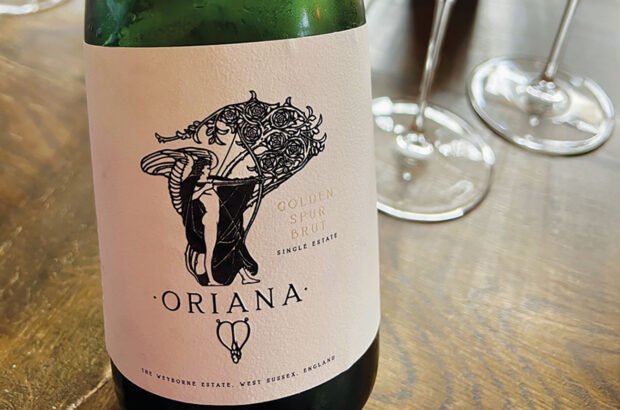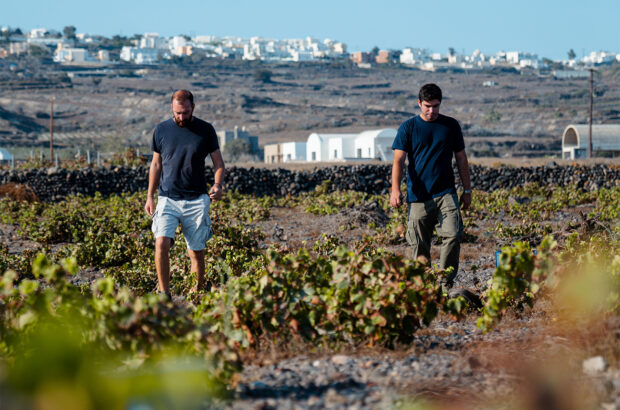The cost of the ambitious Château de Beaucastel cellar project was €12m (£10m), and an inauguration date of 21 May 2025 has been set.
The intention was to extend the winery in readiness for greater capacity in the coming years, but they have used the opportunity to harness the elements – earth, air, sun and water – to greatly reduce their water and energy needs.
To achieve this, they employed a range of ancient and modern methods.

New foudre cellar at Beaucastel. Credit: Nicolas Facenda
Indian architect
The project began in September 2018, when they commissioned the architectural consultancy Because Architecture Matters (BAM) to organise a competition to appoint an architect.
A total of 300 firms, representing 32 nationalities, submitted an entry.
‘We knew that the competition would interest a number of architects, but we never thought it would spark the world-wide enthusiasm that we have experienced,’ said Mathias Boutier, founder of BAM.
From a shortlist of 10, the appointed winner was Studio Mumbai, an internationally renowned Indian architect, who worked on the project in association with Studio Méditerranée, an agency from the south of France specialising in renovation and eco-responsible construction.

‘Just as the earth nourishes grapes, birds and insects, it also influences buildings which form part of this fragile and precious ecosystem. The conception of the architecture will therefore be like a natural evolution of the landscape. Our intention is to create a building that emerges from the ground and returns to the ground. A space that is inhabited by all the living beings on earth,’ said Bijoy Jain, architect and founder of Studio Mumbai. Model credit: Studio Mumbai.
Sustainability first
Some of the original winery buildings have been preserved, and to these have been added a large new wing, much of which is underground. It benefits from the naturally cool and regular temperatures below ground.

The project aimed to use the elements in a number of ways: natural ventilation by chanelling wind, natural cooling through stable underground temperatures, rainwater capture, natural energy through biofuel and solar panels.
To help cool the new winery, and to increase humidity, four large reservoirs have been dug out that are filled with filtered rainwater harvested from the roof.

Underground reservoirs that store captured rainwater. Credit: Beaucastel / BAM
The powerful north wind known as the Mistral is directed through a series of openings and channels, passing over the surface of the water, then flowing through the winery, bringing the air temperature down further to 12°C, requiring neither energy nor expenditure.

The cool Mistral enters through channels and openings, flows into underground galleries and acts as natural ventilation for the winery and assorted buildings. Credit: Nicolas Facenda
Collected rainwater – which should eventually deliver 95% of the estate’s water needs – can also be used for cleaning, cooling and watering the gardens.

Captured rainwater can also be used to water gardens. Credit: Nicolas Facenda
Electricity is generated by roof-mounted solar panels, and will generate almost all of their annual needs.
Sections of the new winery have been constructed partly from aggregates from the demolished buildings, reducing the need for new materials by reusing old ones.

Underground sections are made from ‘site concrete’: a mix of lime, local aggregates and sand excavated from the site. Credit: Nicolas Facenda
Outside walls are made in the pisé (rammed earth) construction technique, using clay excavated from the site to build large raw-earth blocks.
This ancient technique has seen a resurgence in interest recently, as using local materials reduces the environmental impact of construction. An additional benefit is that rammed earth walls also help to regulate the inside temperatures of the building.

Earth excavated from the site is used to make pisé (rammed earth blocks) for the construction of new buildings above ground. Credit: Nicolas Facenda
In addition to the winery, other external buildings, courtyards and gardens have been created for the wellbeing and comfort of staff and guests.

Spaces have been created for the wellbeing of staff and guests. Credits: Nicolas Facenda (left), Iwan Baan (right)
‘Everything works well today,’ said César Perrin, who plans to receive the 2025 harvest at the winery later this year. ‘Nothing will change with the wine. The project is just to be more eco-responsible and to use less energy,’ he said.

Area for reception of grapes at Beaucastel. Credit: Nicolas Facenda







